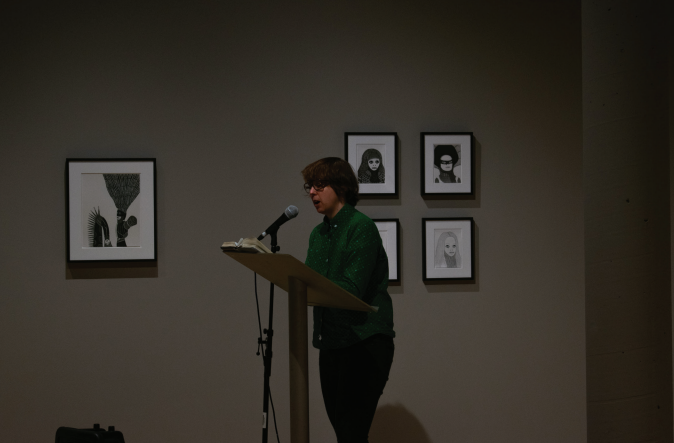“Rainbow Rainbow” author Lydia Conklin visits Fredonia
MARISSA BURR
Opinion Editor

Every four years, there’s an extra day in the calendar year; on Leap Day 2024, the campus welcomed writer and graphic artist Lydia Conklin.
As part of the English Department’s Mary Louise Wright Visiting Writers series, Conklin came to discuss their collection of short stories, “Rainbow Rainbow,” as well as their work as a graphic artist, assistant professor and writer.
To prepare for the event, multiple professors on campus, such as Michael Sheehan and Rebecca Cuthbert, included “Rainbow Rainbow” as part of their required readings. Students then discussed the assigned pieces and delved deeper into Conklin’s messages and writing style.
On Feb. 29, Conklin visited classes to allow for an open forum of conversation about things they’ve learned as a writer, as well as specific questions about the short stories.
They revealed that their favorite piece was the first in the collection, “Laramie Time,” because of how it helped them write characters that made decisions that they never would. At a craft talk held in Fenton Hall at 4:00 p.m. that day, Conklin broke down different aspects of their process when creating the piece.
For example, the title itself was chosen for a few reasons: its “poetic” sound, its ability to represent this in-between place where the characters were living, and the history of Laramie, Wyoming surrounding the murder of Matthew Shepard.
But this wasn’t their original title — they wanted it to be a quote from the story: “I don’t care if my baby makes chairs.” Conklin believed the quote spoke to the character Lee’s inability to connect with her future child as anything more than an abstract thought. In the end, the title was obviously rejected — by many people, Conklin said — and one of their alternatives, “Laramie Time,” was chosen instead.
Conklin also reminded the writers in the room that often, they are asked to show, not tell, what characters are feeling. This was something they focused on heavily in their early years of writing, believing that they couldn’t break this rule at all. “Finding that balance was really hard to strike,” they recalled.
Those attending the craft talk were eager to learn the inspiration behind Conklin’s characters, and how they developed them into people that were both likable yet flawed.
Conklin revealed that in “Laramie Time”: The character Arun, who played the role of the friend, confidant and sperm donor to the lesbian couple, was originally based on their female friend who lives in Laramie, WY.
By changing the inspiration for Arun’s character from a woman to a man, a door was opened to an entirely different character. Whether intentional or not, this could be seen as a beautiful way to validate those in the transgender community; by removing the gender identity they’d been in conflict with since birth, their entire way of going about life is open to change.
The collection as a whole was intended to be an accurate representation of queer relationships. When asked about their inspiration for the plots of their stories, Conklin revealed that “a lot of my stories come from my own experiences, that’s how I connect to them.”
While Conklin only felt comfortable discussing the issues that they themself had faced or felt close to, they took care when writing to make sure that the readers would “see that queer characters are complicated and real people.”
One of the ways they accomplished this was by not over-explaining concepts that those in the queer community would already understand. They kept in enough information that the story could still be understood without that explanation but also made sure it didn’t exhaust queer readers.
Another way they accurately represented queer experiences is that they made their characters make poor decisions. For one, they said, “It’s more exciting to read about characters that are doing things that you wouldn’t do.” They discussed how, in standard fiction, the cisgender protagonist is the only one allowed to make mistakes. Yet, that’s not accurate to real life. So, they decided to re-establish this trope to the queer identity.
“All people are messed up, especially if society hates them,” Conklin explained. They wanted to ensure their characters weren’t perfect and without flaws.
At the end of their visit, they hosted an event at the Marion Art Gallery. After a musical performance by Bridget Brown, Sheehan opened the night by reading Conklin’s biography, including their achievements such as The Stegner Fellowship in Fiction at Stanford University, a grant from the Elizabeth George Foundation and many more. He then discussed “Rainbow Rainbow,” and stated how “they go to dark and real places but also striate light.” Sheehan also commented on the fact that “characters hurt each other, but are written with grace and dignity.”
Conklin read excerpts from “Rainbow Rainbow,” as well as a short story that wasn’t finished at the time of their collection’s publication, but will be released this coming summer. Conklin also gave attendees a glimpse into the first chapter of their next novel, set to be released in June 2025. All three pieces seemed to captivate the audience.
